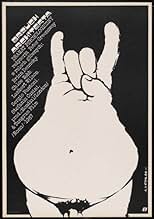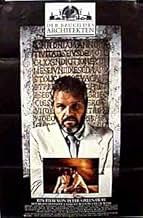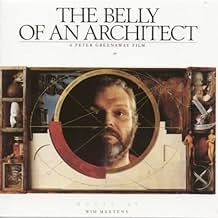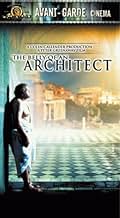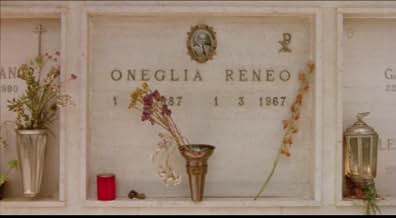AVALIAÇÃO DA IMDb
6,9/10
6,6 mil
SUA AVALIAÇÃO
Adicionar um enredo no seu idiomaAn architect supervising an exhibition starts to have mysterious stomach pains while his life slowly falls apart.An architect supervising an exhibition starts to have mysterious stomach pains while his life slowly falls apart.An architect supervising an exhibition starts to have mysterious stomach pains while his life slowly falls apart.
- Prêmios
- 2 indicações no total
Marino Masé
- Trettorio
- (as Marino Mase)
Avaliações em destaque
An American architect (Dennehy) comes to Rome with his wife to create an exhibition he's been working on for 10years. He is troubled though by a terrible pain in his stomach.
Like all Greenaway's projects, this is decidedly off kilter - though not as much as usual - with his usual structured picture framing and colour (red and green) and fabulous use of music. The wonderful soundtrack here is not by Nyman, but is very similar.
Dennehy is perfect in the lead role, but Chloe Webb as his wife puts in a rather strange stilted performance as his wife.
This starts slow but improves as it goes along as Dennehy's story unfolds. Not for everyone, but lovers of the great director will enjoy this, even if it is more orthodox than usual.
Like all Greenaway's projects, this is decidedly off kilter - though not as much as usual - with his usual structured picture framing and colour (red and green) and fabulous use of music. The wonderful soundtrack here is not by Nyman, but is very similar.
Dennehy is perfect in the lead role, but Chloe Webb as his wife puts in a rather strange stilted performance as his wife.
This starts slow but improves as it goes along as Dennehy's story unfolds. Not for everyone, but lovers of the great director will enjoy this, even if it is more orthodox than usual.
You always know going into a Peter Greenaway film that, for better or for worse, you are going to get something a bit left-field. The Belly of an Architect is really no different in this regard. This one tells the tale of an American architect who travels to Rome with his young wife to supervise an exhibition celebrating the 18th century architect Etienne-Louis Boullée. Very soon after arrival both he and his wife experience contrasting activity in their bellies, for him it is severe abdominal pains while she falls pregnant. To complicate matters, they soon begin affairs with other people. The film essentially then details the architects mental deterioration, which includes writing postcards to his long deceased doppelganger Boullée.
This one has to go down as one of Greenaway's more accessible films. It has an actual story that is underpinned by a good central performance from Brian Dennehy. But its maybe the very fact that it skirts so close to realistic drama that is one of the main problems, as Greenaway is usually best when he does precisely the opposite. The story is really quite boring and the acting aside from Dennehy not all that good – Chloe Webb being particularly flat as his wife; look out also for Stefania (Suspiria) Cassini sporting an unfamiliar cropped 80's barnet. The visuals, while certainly nicely composed, aren't all that memorable. Given that the setting is Rome, there are many shots of that cities peerless architecture, although that all gets almost a bit travelogue to a certain extent. I think this film, therefore, is one for Greenaway devotees almost exclusively as in order to get a lot out of it you have to be interested in his ideas. While I have liked several of his films, I can't deny that, even in the cases of the ones I liked most, his films can be somewhat annoying. Dennehy really helps draw us in to events though and makes a good stab at involving us but it's difficult to care too much about these stiff characters populating a narrative that is both distant and very cold emotionally. Boullée himself is a typically absurd Greenaway figure, in that very little of his architecture ever came to be built, so it's difficult to ever imagine a high profile retrospective of his work ever happening. His rounded, domed buildings mimic the belly of the title, as does his name. So there are many links and symmetries in the story if you are at all interested in that kind of thing. But, while some of the photography was nice and it did have a good score from one of the members of Kraftwerk, it was overall a little tedious for me.
This one has to go down as one of Greenaway's more accessible films. It has an actual story that is underpinned by a good central performance from Brian Dennehy. But its maybe the very fact that it skirts so close to realistic drama that is one of the main problems, as Greenaway is usually best when he does precisely the opposite. The story is really quite boring and the acting aside from Dennehy not all that good – Chloe Webb being particularly flat as his wife; look out also for Stefania (Suspiria) Cassini sporting an unfamiliar cropped 80's barnet. The visuals, while certainly nicely composed, aren't all that memorable. Given that the setting is Rome, there are many shots of that cities peerless architecture, although that all gets almost a bit travelogue to a certain extent. I think this film, therefore, is one for Greenaway devotees almost exclusively as in order to get a lot out of it you have to be interested in his ideas. While I have liked several of his films, I can't deny that, even in the cases of the ones I liked most, his films can be somewhat annoying. Dennehy really helps draw us in to events though and makes a good stab at involving us but it's difficult to care too much about these stiff characters populating a narrative that is both distant and very cold emotionally. Boullée himself is a typically absurd Greenaway figure, in that very little of his architecture ever came to be built, so it's difficult to ever imagine a high profile retrospective of his work ever happening. His rounded, domed buildings mimic the belly of the title, as does his name. So there are many links and symmetries in the story if you are at all interested in that kind of thing. But, while some of the photography was nice and it did have a good score from one of the members of Kraftwerk, it was overall a little tedious for me.
Starring Brian Dennehy, an unusual actor for a Peter Greenaway film, as Kracklite, an architect, a career we don't often see explored in cinema, Greenaway's 'Belly of an Architect' is somehow bigger and more emotionally ambitious than most of his other works, which lack human resonance. In his other films, the characters are uniformly British and so Greenaway's coldness and archness toward them is indicative of a general misanthropy. Here, it's aimed squarely at Romans, whose loose morals and carnivorous practices contrast with the enormity of Kracklite's ego and generosity of spirit. His stomach is being eaten away by some unknown illness or cancer, and this serves as a metaphor for his ego being eaten away by the carnivorousness of Roman culture. His wife, his identity (which is a vicarious one, given his devotion/debt to his idol, Bouleé) and his work are being repossessed by the conquestful Roman carnivores who aim to destroy him simply for the material gain of taking what is so ostentatiously his. But his devotion to Bouleé, his need to make Bouleé's work more widely known, is not a singular or altruistic act; the exhibition he is organizing will make Bouleé more commercial and accessible, but it will also be an addendum to his own career, a manifestation of his ego. His diary is written in the form of letters to Bouleé, to whom he is almost praying as his own personal God. And his devotion to this God is not a selfless one, since Bouleé is so inexorably an element of his own identity.
Rome and its buildings are given a golden, postmodern glow, their clarity enhanced by Wim Mertens' musical score, which adds its own sunlight to the proceedings. But the sunlight that glows throughout Rome and permeates the aura of the film is an impersonal one, an indifferent one, as ancient as the ruins of Rome, which our Roman characters observe have been more useful and influential as ruins than they were prior. "They're better as ruines," a character observes. "Your imagination compensates for what you don't see, like a woman with clothes on." The Romans are depicted here as carnivores (and the word "carnivore" is used multiple times) who not only want to devour and repossess, but want to strip. Brian Dennehy's performance here is indeed stripped, larger than life, fiery. He explodes on screen, bringing the film into another realm, introducing emotional dimensions not often seen in the films of Greenaway; and in this, the film has a power that inhabits the movie's symmetrical form (mostly every shot is symmetrical), its architecture, and threatens to destroy it. The coldness that is typical of Greenaway, that architecturized godlessness, is at war with fiery human passion in all its flawed nakedness.
Greenaway's movies, in their arctic wit and obsession with symmetry, are cinema as architecture more so than storytelling, so 'The Belly of an Architect,' contrary to the claim by many that it's his most mainstream and therefore weakest work, is perhaps his most appropriate film, and maybe his best
Rome and its buildings are given a golden, postmodern glow, their clarity enhanced by Wim Mertens' musical score, which adds its own sunlight to the proceedings. But the sunlight that glows throughout Rome and permeates the aura of the film is an impersonal one, an indifferent one, as ancient as the ruins of Rome, which our Roman characters observe have been more useful and influential as ruins than they were prior. "They're better as ruines," a character observes. "Your imagination compensates for what you don't see, like a woman with clothes on." The Romans are depicted here as carnivores (and the word "carnivore" is used multiple times) who not only want to devour and repossess, but want to strip. Brian Dennehy's performance here is indeed stripped, larger than life, fiery. He explodes on screen, bringing the film into another realm, introducing emotional dimensions not often seen in the films of Greenaway; and in this, the film has a power that inhabits the movie's symmetrical form (mostly every shot is symmetrical), its architecture, and threatens to destroy it. The coldness that is typical of Greenaway, that architecturized godlessness, is at war with fiery human passion in all its flawed nakedness.
Greenaway's movies, in their arctic wit and obsession with symmetry, are cinema as architecture more so than storytelling, so 'The Belly of an Architect,' contrary to the claim by many that it's his most mainstream and therefore weakest work, is perhaps his most appropriate film, and maybe his best
Welcome to Greenaway cinema. Having seen only his 'hit' The Cook the Thief His Wife & Her Lover(1989) and this, I cannot say much for the sum of his films. I will simply try to find and watch more film of his. His comments and quotes here in IMDb are impressive as well.
On to the film: Shot in Rome, it will thrill people with interest on architecture both visually, but thematically as well, well at least at some points. The musical score is stunning. It suits the theme and climax that Greenaway masterfully builds. As with The Cook the Thief His Wife & Her Lover, it is not various separate songs. All the soundtrack songs together form a thriumph of visual and audio art, suggesting my point about the importance of film soundtracks for an effective impact on viewer. This is a sad story, but it features some light points where joy and lust for life is celebrated - at least for my eyes and ears.
Those who criticise Greenaway for attempting only to shock the viewers have simply lost the point. Anyway. The Belly of an architect is no violent film, so it is highly recommended to those interested in films, maybe a bit 'arty', but with heart .
On to the film: Shot in Rome, it will thrill people with interest on architecture both visually, but thematically as well, well at least at some points. The musical score is stunning. It suits the theme and climax that Greenaway masterfully builds. As with The Cook the Thief His Wife & Her Lover, it is not various separate songs. All the soundtrack songs together form a thriumph of visual and audio art, suggesting my point about the importance of film soundtracks for an effective impact on viewer. This is a sad story, but it features some light points where joy and lust for life is celebrated - at least for my eyes and ears.
Those who criticise Greenaway for attempting only to shock the viewers have simply lost the point. Anyway. The Belly of an architect is no violent film, so it is highly recommended to those interested in films, maybe a bit 'arty', but with heart .
I always know I can turn to Greenaway for nested worlds. He's one of few who can - not always mind, but the few occasions are precious - align the notions of image, how they project outwards to form what we know of reality - an empty field of anxious, random forces tossing us around - and the interior springwell from where these images flow out and which reveals ourselves to be in control of them. The play is usually given to us by some sort of fiction passing as real, or a charade within another, a story within itself, so that we may be directed from the confines of the narrow frame into a broader view that includes it.
The idea is especially powerful in the context of architecture, that we use form to project outwards a set of ideals but, having understood ourselves eventually circumscribed by structures that describe us, we can then use them to describe the inner landscape.
So indeed, we stroll around one such interior Rome, where earlier decadence or glory, or masks thereof, greeting us from marble balustrades and rows of pillars reflect inside. A city so ornately decorated and cast in stone, as though man would outlast his follies.
Into this comes an American architect - the man whose folly is to build things that last - to stage an exhibition for some obscure French architect who died 180 years ago. Italians are not too happy that he hasn't picked one of their own, but they oblige to finance nonetheless.
There are two broad ideas that Greenaway is careful to lightly caress, tease out their potential implications, but finally circumnavigate. The film would have been lesser had it settled on either, or is perhaps greater for encompassing both.
One is the doubling; the architect begins to imagine himself as his older counterpart, writing letters to him in the form of private confessional; then begins imagining himself as emperor Augustus, trapped in the same ploy of marital infidelity and murder. He replicates these stories around him. So these people overlap and are mirrored with bellies, bellies aching with the toll of creation. At this point you may think it is all going to be another film about the creative person losing himself in the mind, merging life with narrative.
The other is, as always with Greenaway, about all this as doubling for the making of the film. It's a film-within device, make no mistake. So the visionary artist is increasingly frustrated by lackeys, ignorant money-men, virulent antagonists scheming to usurp him; energy is wasted in duplicitous dinner parties and idle, but always more or less venomous, chit-chat, until eventually finds himself embittered and alone in his own set.
But it is not merely about the price of genius, or a satire of the contemporary civilized arena that it has to bleed into.
Look for the scene with his doctor in front of the busts of emperors; each bust a face and story, one decadent and evil, another perhaps famed as wise, but all inadvertently gone. A little further down is a bust without name, it could be anyone's, and whatever story will be inscribed upon it, it's again only destined to join this gallery of fiction. It is important to see these follies, but more important to see the continuity.
So it is this acceptance on the part of the architect, the man who builds things not only to last but to be beautiful in time, of the turn of the wheel, decline through rebirth. It is powerful stuff to see; the scene in the police station near the end, where he is simply asked name and age, whether married or not. He is free to go then. He has been jotted down in the ledgers.
The final scenes in the exhibition center echo with this casual dismissal of a life lived, a casual but sweet, relieving it would seem, departure after so much grief with nothing to weigh on the shoulders. He attends the exhibition, the work of a lifetime, from the balustrade above, from the vantage point of not being involved anymore. Everything looks like a small ceremony from there. So this is the nested world that matters; not the exhibition, but the creative life on the ego-redemptive journey through life at large, purging itself of itself, after the painful struggle to master the world building pantheons finally submitting to be the mastered world, transient, as it comes into being and goes again.
As he goes, new life is born down below - and plays, again and again it would seem, before the colossal marble structures.
It is perhaps the ideal Greenaway film; the self-referential tics are all present, the framework ornate, but instead of chaotic it is all mastered into a pillar that supports, unifies vision. The architect - on more levels than one - coming to terms with the architecture of a transient life.
The idea is especially powerful in the context of architecture, that we use form to project outwards a set of ideals but, having understood ourselves eventually circumscribed by structures that describe us, we can then use them to describe the inner landscape.
So indeed, we stroll around one such interior Rome, where earlier decadence or glory, or masks thereof, greeting us from marble balustrades and rows of pillars reflect inside. A city so ornately decorated and cast in stone, as though man would outlast his follies.
Into this comes an American architect - the man whose folly is to build things that last - to stage an exhibition for some obscure French architect who died 180 years ago. Italians are not too happy that he hasn't picked one of their own, but they oblige to finance nonetheless.
There are two broad ideas that Greenaway is careful to lightly caress, tease out their potential implications, but finally circumnavigate. The film would have been lesser had it settled on either, or is perhaps greater for encompassing both.
One is the doubling; the architect begins to imagine himself as his older counterpart, writing letters to him in the form of private confessional; then begins imagining himself as emperor Augustus, trapped in the same ploy of marital infidelity and murder. He replicates these stories around him. So these people overlap and are mirrored with bellies, bellies aching with the toll of creation. At this point you may think it is all going to be another film about the creative person losing himself in the mind, merging life with narrative.
The other is, as always with Greenaway, about all this as doubling for the making of the film. It's a film-within device, make no mistake. So the visionary artist is increasingly frustrated by lackeys, ignorant money-men, virulent antagonists scheming to usurp him; energy is wasted in duplicitous dinner parties and idle, but always more or less venomous, chit-chat, until eventually finds himself embittered and alone in his own set.
But it is not merely about the price of genius, or a satire of the contemporary civilized arena that it has to bleed into.
Look for the scene with his doctor in front of the busts of emperors; each bust a face and story, one decadent and evil, another perhaps famed as wise, but all inadvertently gone. A little further down is a bust without name, it could be anyone's, and whatever story will be inscribed upon it, it's again only destined to join this gallery of fiction. It is important to see these follies, but more important to see the continuity.
So it is this acceptance on the part of the architect, the man who builds things not only to last but to be beautiful in time, of the turn of the wheel, decline through rebirth. It is powerful stuff to see; the scene in the police station near the end, where he is simply asked name and age, whether married or not. He is free to go then. He has been jotted down in the ledgers.
The final scenes in the exhibition center echo with this casual dismissal of a life lived, a casual but sweet, relieving it would seem, departure after so much grief with nothing to weigh on the shoulders. He attends the exhibition, the work of a lifetime, from the balustrade above, from the vantage point of not being involved anymore. Everything looks like a small ceremony from there. So this is the nested world that matters; not the exhibition, but the creative life on the ego-redemptive journey through life at large, purging itself of itself, after the painful struggle to master the world building pantheons finally submitting to be the mastered world, transient, as it comes into being and goes again.
As he goes, new life is born down below - and plays, again and again it would seem, before the colossal marble structures.
It is perhaps the ideal Greenaway film; the self-referential tics are all present, the framework ornate, but instead of chaotic it is all mastered into a pillar that supports, unifies vision. The architect - on more levels than one - coming to terms with the architecture of a transient life.
Você sabia?
- CuriosidadesBrian Dennehy was quoted after the release as saying "I've made lots of movies but this is my first film."
- Erros de gravaçãoWhen photocopying the picture of Augustus, Kracklite puts the picture in upside-down which would have given a blank copy. Additionally, it would not be possible to achieve the level of resolution of Augustus's abdomen from such a small picture.
- Citações
Caspasian Speckler: Your wife is very beautiful, Signor Kracklite, especially when she is pregnant.
Stourley Kracklite: Yes, that's right. She is pregnant. But not with your child, Speckler.
Caspasian Speckler: True. I'm very grateful to you for that. Your child, shall we say, is the most perfect contraceptive.
[Kracklite turns and punches Speckler in the nose]
- ConexõesFeatured in Peter Greenaway (1992)
Principais escolhas
Faça login para avaliar e ver a lista de recomendações personalizadas
- How long is The Belly of an Architect?Fornecido pela Alexa
Detalhes
- Data de lançamento
- Países de origem
- Idiomas
- Também conhecido como
- The Belly of an Architect
- Locações de filme
- Empresas de produção
- Consulte mais créditos da empresa na IMDbPro
Bilheteria
- Faturamento bruto nos EUA e Canadá
- US$ 287.725
- Tempo de duração
- 1 h 59 min(119 min)
- Cor
- Mixagem de som
- Proporção
- 1.85 : 1
Contribua para esta página
Sugerir uma alteração ou adicionar conteúdo ausente


